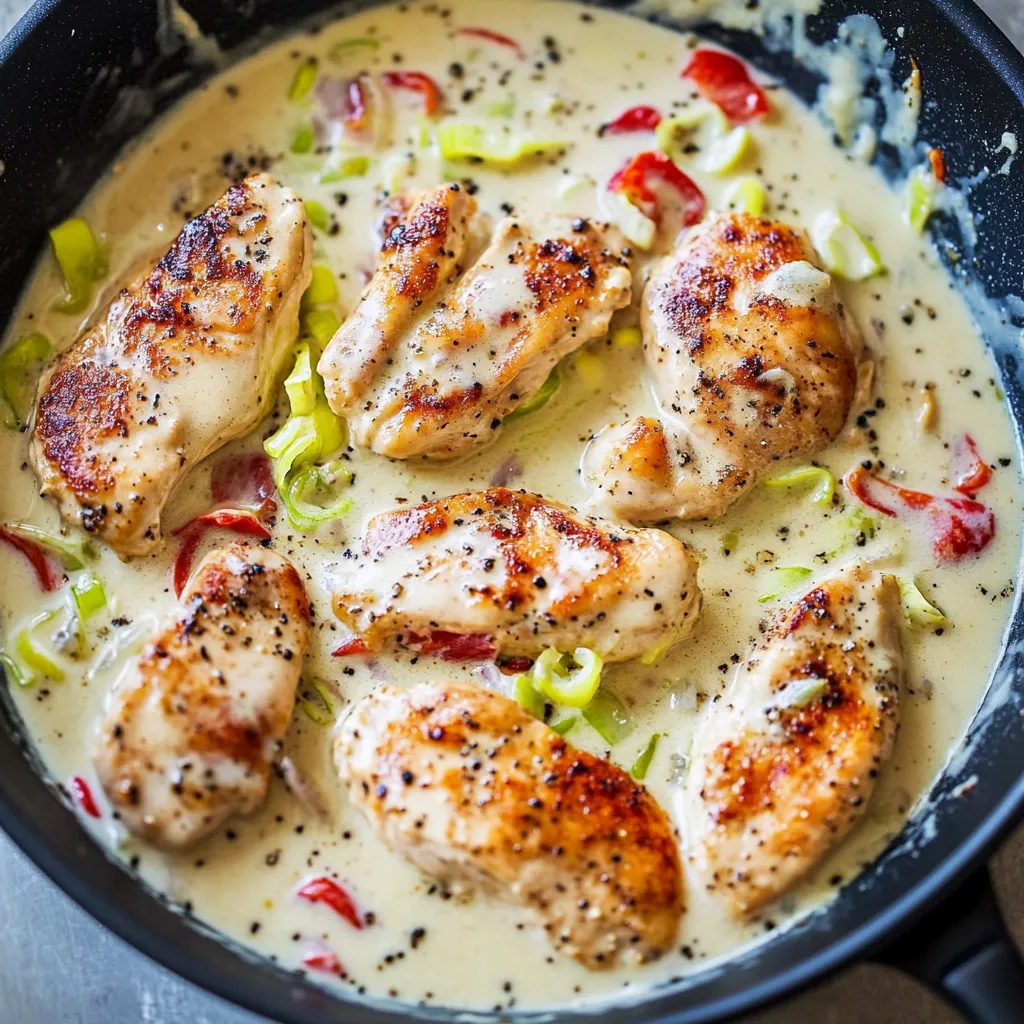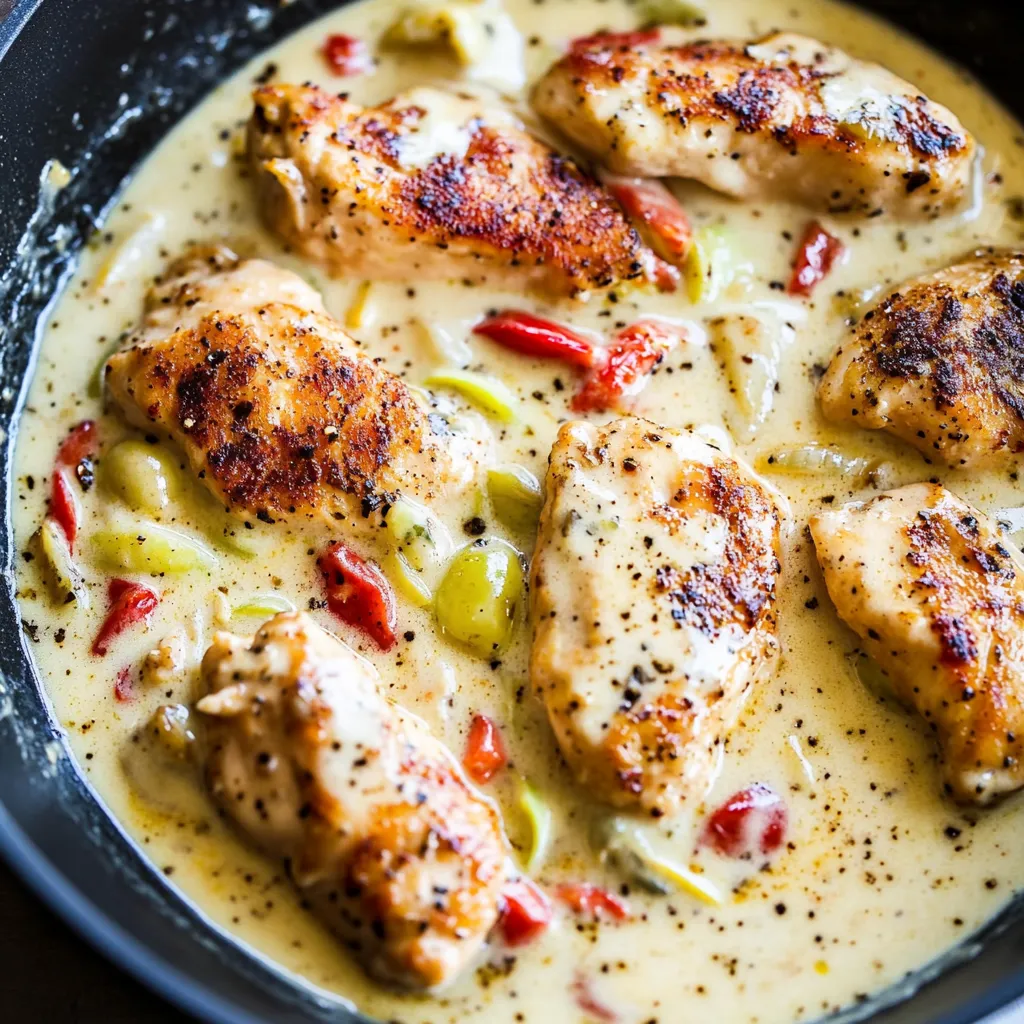 Pin it
Pin it
This extraordinary creamy pepperoncini chicken skillet transforms humble chicken tenders into a restaurant-quality dinner that delivers an irresistible combination of tangy, spicy pepperoncini peppers balanced perfectly with rich, velvety cream sauce that clings beautifully to every piece of golden-seared chicken. The genius of this one-pot wonder lies in its brilliant flavor layering technique - building depth through proper searing, deglazing with chicken stock, then finishing with heavy cream and Parmesan to create a luxurious sauce that showcases the distinctive bright, pickle-like tang of pepperoncini peppers without overwhelming the palate. Unlike complicated cream sauces that require multiple pans and precise timing, this skillet method allows you to build complex flavors in a single pan while creating a complete, satisfying meal that works equally well over pasta for indulgent comfort food or over cauliflower rice for low-carb elegance.
I perfected this recipe when craving the distinctive tang of pepperoncini peppers in a substantial dinner format, and the breakthrough came when I realized that reducing the chicken stock before adding cream creates better flavor concentration while preventing the sauce from breaking during the final cooking phase.
Essential Ingredients and Selection Tips
- Chicken tenders: Choose plump, evenly-sized tenders for consistent cooking; if using breasts, slice into uniform strips for even browning
- Quality pepperoncini: Look for bright, firm peppers in clear brine; avoid mushy or overly salty varieties that could overwhelm the dish
- Heavy cream: Essential for proper sauce consistency; avoid half-and-half which won't create the same rich, clingy texture
- Fresh Parmesan cheese: Grate your own for best melting and flavor; pre-shredded contains anti-caking agents that affect sauce smoothness
- Roasted red peppers: Adds sweetness and color contrast; drain thoroughly to prevent excess moisture in the sauce
- Quality chicken stock: Use low-sodium version to control salt levels; bone broth adds extra richness if available
The secret to perfect results is proper searing for flavor development and temperature control when adding cream to prevent breaking.
Detailed Step-by-Step Instructions
- Step 1: Season chicken properly:
- Pat chicken tenders dry and season generously with salt and pepper on both sides for optimal flavor penetration.
- Step 2: Sear for maximum flavor:
- Heat butter in large skillet over medium-high heat until foaming, then brown chicken tenders for 3-4 minutes per side until golden.
- Step 3: Remove and rest chicken:
- Transfer seared chicken to plate and cover to keep warm while building the sauce base.
- Step 4: Build aromatic base:
- Add diced onion to same skillet and cook 3-4 minutes until softening, then add garlic and cook 1 minute more.
- Step 5: Deglaze and reduce:
- Pour in chicken stock, scraping up browned bits, then add sliced roasted red peppers and simmer until liquid reduces by half.
- Step 6: Add cream carefully:
- Remove skillet from heat temporarily and slowly whisk in heavy cream to prevent curdling from temperature shock.
- Step 7: Incorporate cheese:
- Add grated Parmesan while whisking continuously until melted and sauce is smooth and creamy.
- Step 8: Return to gentle heat:
- Place skillet back on medium-low heat and add Italian seasoning, stirring to distribute evenly.
- Step 9: Finish with peppers and chicken:
- Add pepperoncini peppers and nestle chicken tenders back into sauce, simmering until chicken reaches 165°F internal temperature.
- Step 10: Final seasoning and service:
- Taste sauce and adjust seasoning as needed, then serve immediately over chosen base while sauce is hot and creamy.
 Pin it
Pin it
The most important technique is controlling heat when adding cream and not overcooking the chicken during the final simmer.
This pepperoncini chicken skillet has become my go-to example of how unique ingredients can transform familiar dishes into something special and memorable.
Understanding Searing Science and Flavor Development
Proper searing of the chicken creates the Maillard reaction that develops complex flavors and appealing color while creating fond (browned bits) that becomes the foundation for the sauce. The key is ensuring the pan is hot enough and not overcrowding, which would cause steaming rather than browning.
Sauce Construction and Emulsion Stability
Building the sauce through reduction and careful cream addition creates a stable emulsion that won't break during final cooking. Removing the pan from heat before adding cream prevents temperature shock that could cause curdling, while the starch from the reduced stock helps stabilize the final sauce.
Pepperoncini Integration and Heat Balance
Pepperoncini peppers provide both tang and mild heat that needs balance with the rich cream base. Their acidic brine also helps brighten the overall dish, preventing the cream sauce from feeling heavy or monotonous while adding visual appeal and textural contrast.
Temperature Management and Protein Safety
Controlling heat throughout cooking ensures the chicken stays tender while reaching safe internal temperature. The final gentle simmer in the sauce finishes cooking the chicken while allowing flavors to meld without overcooking the protein or breaking the cream sauce.
Reduction Techniques and Flavor Concentration
Reducing the chicken stock before adding cream concentrates flavors and creates better sauce consistency. This technique also removes excess water that could thin the final sauce or prevent proper adhesion to the chicken and serving base.
This creamy pepperoncini chicken skillet has taught me that the most memorable dishes often come from taking familiar comfort food techniques and introducing unexpected flavor elements that elevate the entire experience. Every time I make it, I'm reminded that some of the best home cooking happens when you combine solid technique with bold flavor choices, creating meals that feel both comforting and sophisticated, proving that weeknight dinners don't have to be boring or predictable when you're willing to experiment with distinctive ingredients like pepperoncini that bring personality and excitement to otherwise simple preparations.
Frequently Asked Questions
- → Can I use chicken thighs instead of strips?
- Yes, boneless chicken thighs work great. Cut them into bite-sized pieces and cook until they reach 165°F internal temperature.
- → What can I serve this chicken over?
- This pairs perfectly with rice, pasta, mashed potatoes, or steamed vegetables. You can also enjoy it on its own with some crusty bread.
- → Can I make this dish ahead of time?
- Yes, you can make it a day ahead. Store in the fridge and reheat gently on the stove, adding a splash of chicken stock if the sauce thickens too much.
- → How spicy are pepperoncini peppers?
- Pepperoncini are very mild with just a slight tang. They're not spicy at all, so this dish is family-friendly and safe for kids.
- → Can I substitute the heavy cream?
- You can use half-and-half for a lighter version, but the sauce won't be as thick. Avoid milk as it may curdle when heated with the other ingredients.
- → How do I know when the chicken is fully cooked?
- Use a meat thermometer to check that the thickest part of the chicken reaches 165°F. The meat should also be white throughout with no pink areas.
